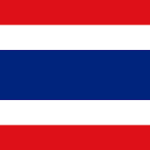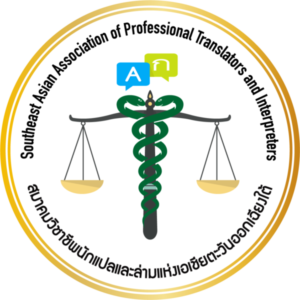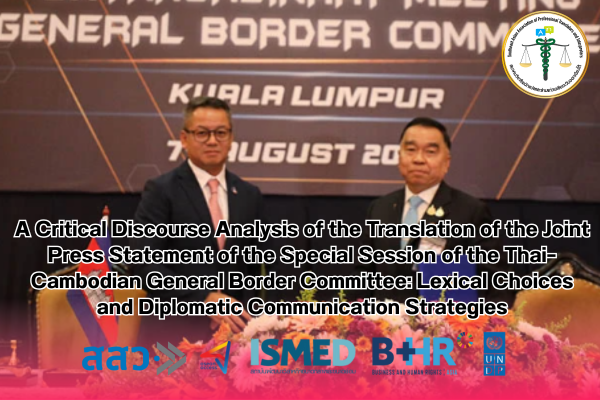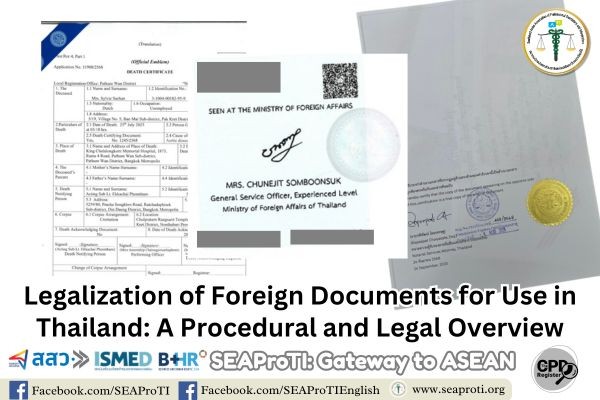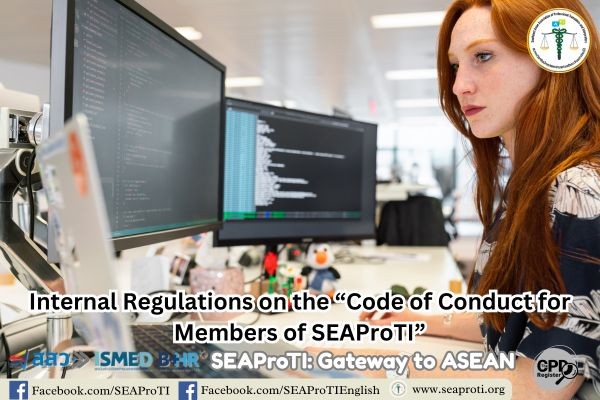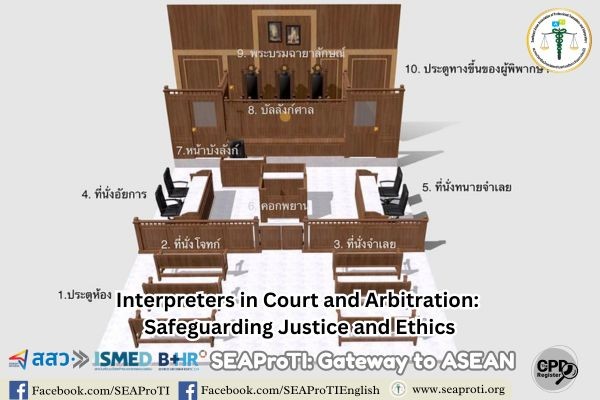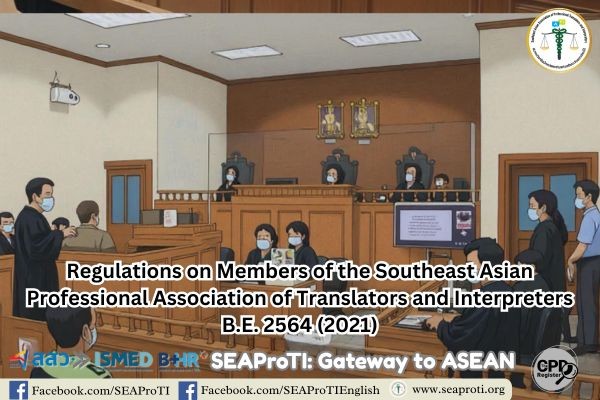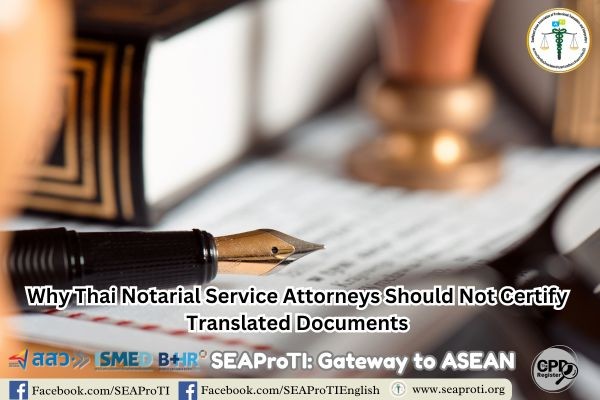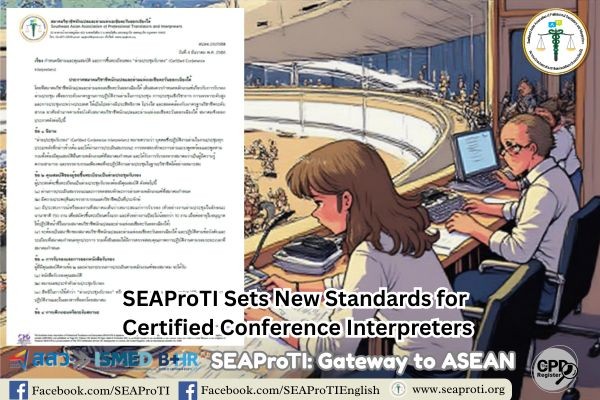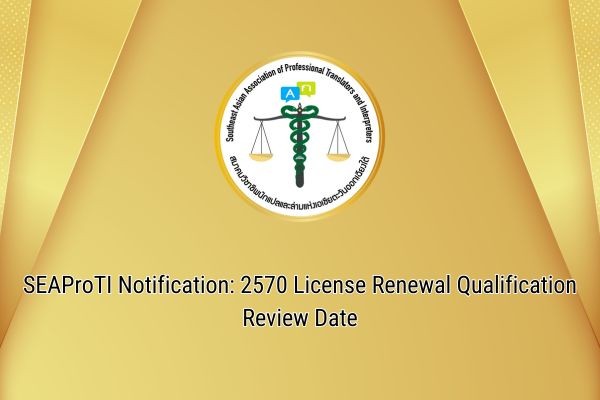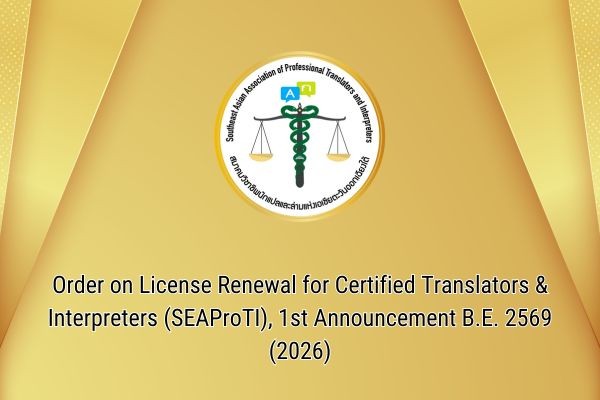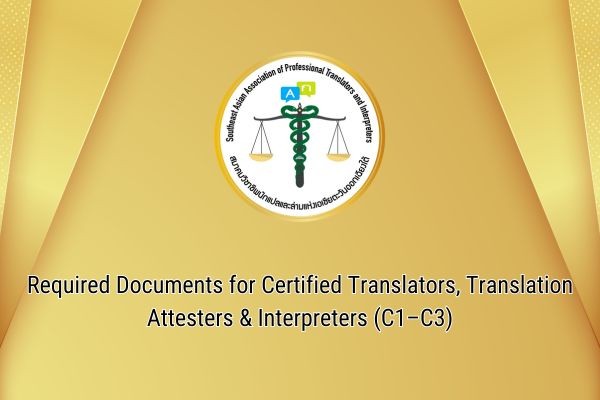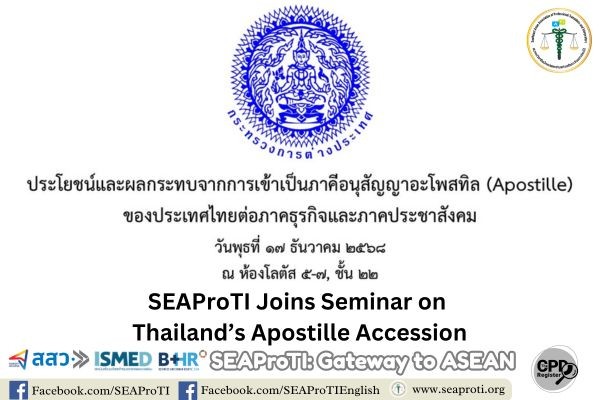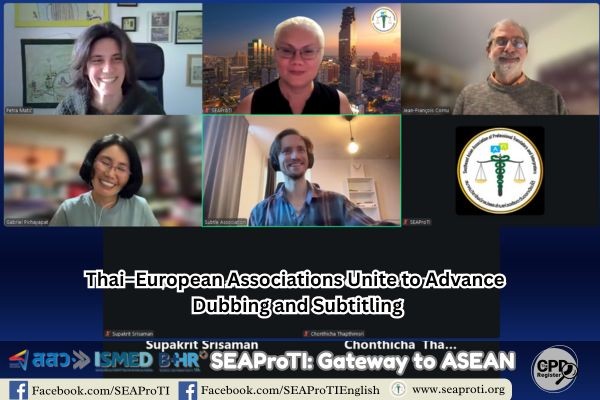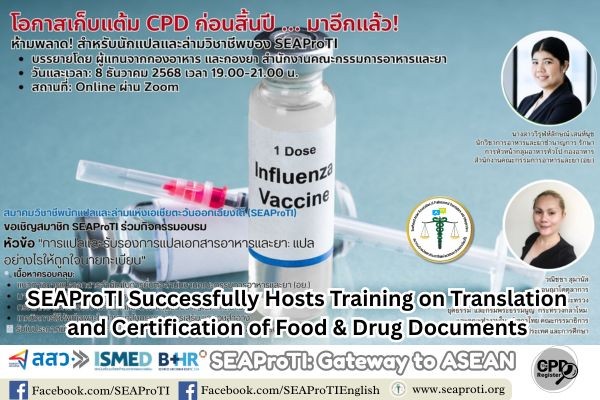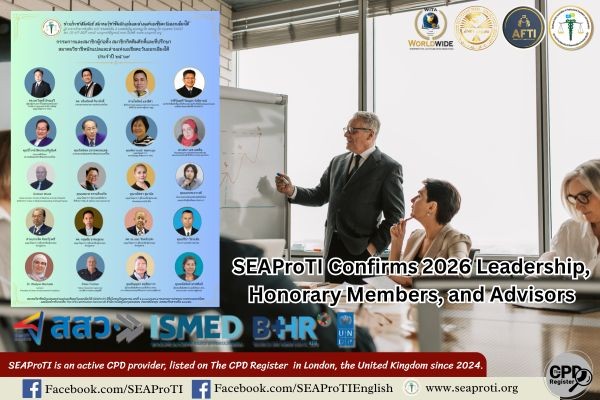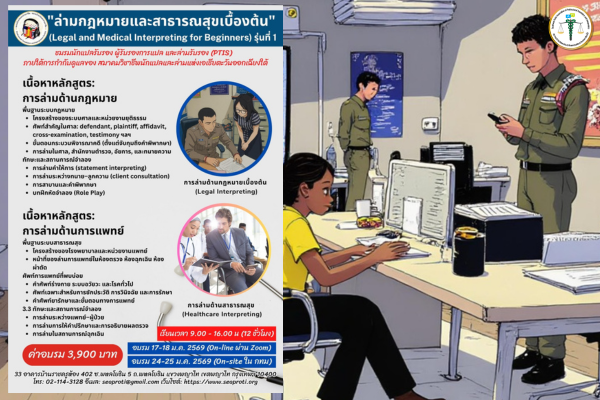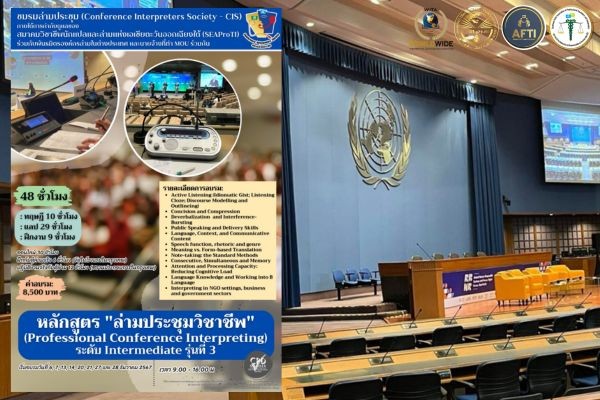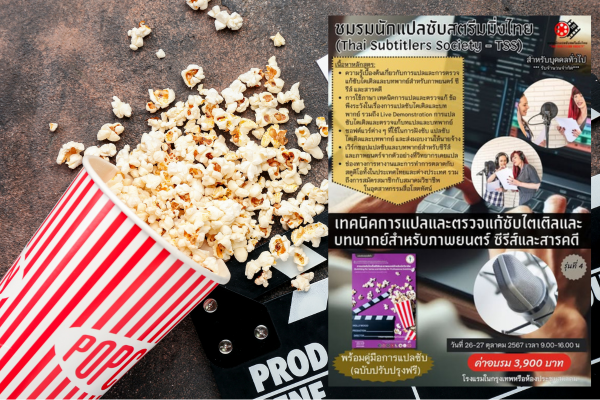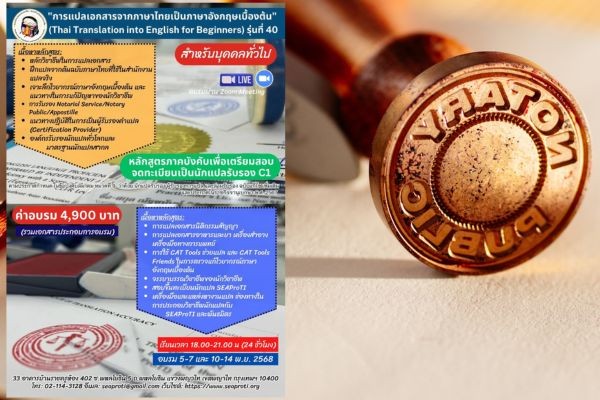A Critical Discourse Analysis of the Translation of the Joint Press Statement of the Special Session of the Thai–Cambodian General Border Committee: Lexical Choices and Diplomatic Communication Strategies
10 August 2025
Author: Wanitcha Sumanat, president of the Southeast Asian Association of Professional Translators and Interpreters (SEAProTI)
Abstract
This article presents a Critical Discourse Analysis (CDA) comparing the original English version of the joint press statement issued at the Special Session of the Thai–Cambodian General Border Committee (GBC) on 7 August 2025 with its official Thai translation published by the Ministry of Foreign Affairs of Thailand. Using the analytical framework of Fairclough (1995) and van Dijk (1998), the study examines the text level, discursive practice, and social practice. Findings reveal that the translator employed lexical and structural adjustments to maintain diplomatic balance, de-escalate discursive conflict, and emphasise consistency with the framework of International Humanitarian Law (IHL) and the Geneva Conventions.
Keywords: diplomatic translation, Critical Discourse Analysis, General Border Committee, Thailand–Cambodia, international discourse
1. Introduction
The translation of diplomatic documents plays a crucial role in international communication, particularly in the sensitive context of border disputes, which involve political, security, and national image considerations. The Special Session of the General Border Committee (GBC) between the Kingdom of Thailand and the Kingdom of Cambodia, held on 7 August 2025 in Kuala Lumpur, Malaysia, served as an important platform where both countries agreed on ceasefire measures and monitoring mechanisms. The joint press statement issued after the meeting was a strategic discursive instrument. This analysis focuses on comparing the Ministry of Foreign Affairs’ official Thai translation with the original English version, examining the translator’s lexical choices and diplomatic adjustments.
2. Methodology
The analysis adopts the Critical Discourse Analysis (CDA) framework proposed by Fairclough (1995) and van Dijk (1998), divided into three levels:
- Text Level – Examining lexical choices, sentence structures, agentless constructions, and the creation of positive semantic prosody.
- Discursive Practice – Analysing the processes of text production and dissemination as an official state document.
- Social Practice – Exploring the relationship between the text and the socio-political context following the border clashes.
Primary data consisted of the original English statement and the official Thai translation published on the Ministry’s website.
3. Findings
3.1 Text Level
Significant changes were identified as follows:
- Positive emphasis: Effective ceasefire was rendered as “หยุดยิงอย่างเต็มที่และมีประสิทธิผล” (“full and effective ceasefire”), adding adverbs to underscore commitment.
- Neutral conflict terminology: Prisoners of war or captured personnel was translated as “ทหารที่อยู่ในความควบคุมของฝ่ายตรงข้าม” (“soldiers under the control of the opposing side”), softening the warlike connotation.
- Emphasis on international law: Strict respect for humanitarian principles was translated literally as “ให้การเคารพอย่างเคร่งครัดต่อหลักการมนุษยธรรม” (“strict respect for humanitarian principles”), explicitly linking to IHL.
- Polite diplomatic tone: Agreed was rendered as “เห็นชอบร่วมกัน” (“mutually agreed”), highlighting voluntariness and equality.
3.2 Discursive Practice
The translator, as a state official, was responsible not only for conveying meaning but also for controlling tone in alignment with Thailand’s foreign policy. Lexical choices reinforced the discourse of “reasonable, law-abiding partners,” aligning with the image Thailand sought to project within ASEAN.
3.3 Social Practice
The document was issued in the aftermath of border clashes, under political and diplomatic pressure. Balanced language reflected a de-escalation discourse strategy, avoiding direct blame and focusing on cooperation for long-term stability.
Translator’s Choices & Motivations
- Diplomatic and legal tone: Selecting terms with legal resonance, e.g., “หลีกเลี่ยงการโจมตีที่ไม่ได้เกิดจากการยั่วยุ” (“avoid unprovoked attacks”), reflecting jus ad bellum and rules of engagement.
- Emphasis on sovereignty and humanitarian principles: Strengthening connections to international law and the Geneva Conventions.
- Softening of strong war terms: Avoiding direct terms like “เชลยศึก” (“prisoners of war”) to maintain politeness and reduce conflict intensity.
- Positive reinforcement: Adding adjectives/adverbs such as “อย่างเต็มที่” (“fully”), “อย่างมีประสิทธิผล” (“effectively”), “อย่างเคร่งครัด” (“strictly”) to convey commitment.
- Alignment with state communication: Incorporating familiar state expressions such as “เพื่อประโยชน์ร่วมกันอย่างยั่งยืน” (“for sustainable mutual benefit”).
CDA Analysis Using Fairclough & van Dijk
Text Level:
- Formal, legalistic, and diplomatic Thai register; longer, multi-phrase constructions typical of official Thai.
- Nominalisation (e.g., “การหยุดยิง” / “the ceasefire”, “การดำเนินการยั่วยุ” / “provocative acts”) made statements sound factual and agentless, avoiding direct attribution of blame.
- Voluntary mutuality is expressed through verbs like “เห็นชอบร่วมกัน” (“jointly agreed”).
Discursive Practice:
- Strategic rather than literal translation to align with Thai government discourse, emphasising “non-violation of agreements,” “humanitarian principles,” and “avoidance of provocation.”
Social Practice:
- Post-border clash context required de-escalatory language to foster trust in ASEAN forums.
- Word choice reinforced Thailand’s image as a rational, law-abiding partner ready to cooperate with neighbours.
- Use of “บุคคลพลเรือน” (“civilian persons”) instead of “ประชาชน” (“people”) linked more directly to IHL categories.
4. Discussion
The Thai translation of the joint press statement demonstrates the application of diplomatic translation strategies, involving lexical selection, semantic adjustment, and the use of state-aligned idioms. Translation here functions not merely as a linguistic process but as a framing device influencing readers’ interpretation in the realm of international politics.
5. Conclusion
The Thai translation of the Thai–Cambodian GBC joint press statement reflects the strategic role of diplomatic translation in shaping a state’s image. Lexical choices serve both communicative and negotiative functions in discourse. This study highlights the importance of analysing international document translation through both linguistic and contextual lenses to fully understand state-level communication mechanisms.
Appendix
Linguistic Differences: English → Thai
| Term / Phrase Category | Original English (Inferred from Diplomatic Wording) | MFA Thai Translation | Nature of Semantic Transformation |
|---|---|---|---|
| Ceasefire | ceasefire, effective ceasefire, implementation of ceasefire | “หยุดยิง”, “ดำเนินการหยุดยิงอย่างเต็มที่และมีประสิทธิผล” (“ceasefire”, “fully and effectively implement the ceasefire”) | Added “fully and effectively” to emphasise commitment and performance |
| Avoid provocation | refrain from any provocation | “ละเว้นจากการดำเนินการยั่วยุใด ๆ” (“refrain from undertaking any provocation”) | Retained the core meaning but inserted “undertake” to enhance formality |
| Civilian targets | civilian persons and civilian objects | “บุคคลพลเรือนและเป้าหมายทางพลเรือน” (“civilian persons and civilian targets”) | Preserved parallel structure (persons / targets) |
| Territorial integrity | territorial integrity | “อธิปไตย” (“sovereignty”) – sometimes combined with “sovereignty” in translation | Adapted to a familiar Thai term with strong legal-political weight |
| Prisoners of war | personnel under the control of the opposing side | “ทหารที่อยู่ในความควบคุมของฝ่ายตรงข้าม” (“soldiers under the control of the opposing side”) | Avoided “prisoners of war,” which carries sensitive connotations in the present context |
| Respect for humanitarian principles | strict respect for humanitarian principles | “ให้การเคารพอย่างเคร่งครัดต่อหลักการมนุษยธรรม” (“strictly give respect to humanitarian principles”) | Literal rendering but added “give” to enhance ceremonial tone |
| Disinformation | dissemination of false information or fake news | “การเผยแพร่ข้อมูลเท็จหรือข่าวปลอม” (“dissemination of false information or fake news”) | Retained structure but used “ข่าวปลอม” (“fake news”), a contemporary and easily understood term |
| ASEAN Observers | ASEAN observer team led by Malaysia | “คณะผู้สังเกตการณ์จากประเทศสมาชิกอาเซียนซึ่งนำโดยมาเลเซีย” (“observer delegation from ASEAN member states led by Malaysia”) | Expanded “ASEAN” to “ASEAN member states” to highlight multilateral cooperation |
References
- Fairclough, N. (1995). Critical discourse analysis: The critical study of language. London: Longman.
- van Dijk, T. A. (1998). Ideology: A multidisciplinary approach. London: SAGE Publications.
- Ministry of Foreign Affairs of Thailand. (2025, August 7). Joint press statement: Special session of the General Border Committee between the Kingdom of Cambodia and the Kingdom of Thailand. Bangkok: MFA.
- United Nations. (1949). Geneva Convention relative to the Treatment of Prisoners of War (Third Geneva Convention).
- Joint press statement: Special session of the General Border Committee between the Kingdom of Cambodia and the Kingdom of Thailand, Kuala Lumpur, Malaysia, 7 August 2025.
About Certified Translators, Translation Certification Providers, and Certified Interpreters of the Southeast Asian Association of Professional Translators and Interpreters (SEAProTI)
The Southeast Asian Association of Professional Translators and Interpreters (SEAProTI) has established criteria and qualifications for those registered as “Certified Translators,” “Translation Certification Providers,” and “Certified Interpreters” of the Association, as stipulated in Sections 9 and 10 in the Royal Gazette of the Secretariat of the Cabinet, Office of the Prime Minister of the Kingdom of Thailand, dated 25 July 2024, Volume 141, Part 66 Ng, page 100. Full text available at: The Royal Thai Government Gazette
การวิเคราะห์เชิงวาทกรรมวิพากษ์คำแปลแถลงข่าวร่วม การประชุมคณะกรรมการชายแดนทั่วไป สมัยวิสามัญ ไทย–กัมพูชา:
มุมมองด้านการเลือกคำศัพท์และกลยุทธ์การสื่อสารทางการทูต
10 สิงหาคม 2568
ผู้เขียน: วณิชชา สุมานัส สมาคมวิชาชีพนักแปลและล่ามแห่งเอเชียตะวันออกเฉียงใต้ (SEAProTI)
บทคัดย่อ
บทความนี้นำเสนอการวิเคราะห์เชิงวาทกรรมวิพากษ์ (Critical Discourse Analysis: CDA) เปรียบเทียบต้นฉบับภาษาอังกฤษของแถลงข่าวร่วมในการประชุมคณะกรรมการชายแดนทั่วไป (GBC) สมัยวิสามัญ ไทย–กัมพูชา เมื่อวันที่ 7 สิงหาคม 2568 กับฉบับคำแปลภาษาไทยที่เผยแพร่โดยกระทรวงการต่างประเทศของไทย โดยใช้กรอบการวิเคราะห์ของ Fairclough (1995) และ van Dijk (1998) เพื่อพิจารณาระดับถ้อยคำ (text level) การผลิตและการใช้ข้อความ (discursive practice) และบริบททางสังคม (social practice) ผลการวิเคราะห์พบว่าผู้แปลเลือกใช้คำศัพท์และโครงสร้างทางภาษาเพื่อสร้างสมดุลทางการทูต ลดความขัดแย้งเชิงวาทกรรม และเน้นความสอดคล้องกับกรอบกฎหมายมนุษยธรรมระหว่างประเทศ (IHL) และอนุสัญญาเจนีวา
คำสำคัญ: การแปลเชิงการทูต, Critical Discourse Analysis, คณะกรรมการชายแดนทั่วไป, ไทย–กัมพูชา, วาทกรรมระหว่างประเทศ
1. บทนำ
การแปลเอกสารทางการทูตมีบทบาทสำคัญต่อการสื่อสารระหว่างประเทศ โดยเฉพาะในบริบทความขัดแย้งชายแดนซึ่งมีความละเอียดอ่อนทั้งด้านการเมือง ความมั่นคง และภาพลักษณ์ของรัฐ การประชุมคณะกรรมการชายแดนทั่วไป (General Border Committee: GBC) สมัยวิสามัญระหว่างราชอาณาจักรไทยและราชอาณาจักรกัมพูชา เมื่อวันที่ 7 สิงหาคม 2568 ณ กรุงกัวลาลัมเปอร์ ประเทศมาเลเซีย เป็นเวทีสำคัญที่ทั้งสองประเทศตกลงมาตรการหยุดยิงและกลไกติดตาม การแถลงข่าวร่วมจึงเป็นเอกสารที่มีความหมายเชิงยุทธศาสตร์ด้านวาทกรรม การวิเคราะห์นี้มุ่งเน้นการเปรียบเทียบคำแปลภาษาไทยของกระทรวงการต่างประเทศกับต้นฉบับภาษาอังกฤษ เพื่อศึกษากลยุทธ์การเลือกถ้อยคำและการปรับความหมายในเชิงการทูต
2. ระเบียบวิธีวิจัย
การวิเคราะห์ใช้กรอบ Critical Discourse Analysis (CDA) ของ Fairclough (1995) และ van Dijk (1998) โดยแบ่งออกเป็น 3 ระดับ ได้แก่
- Text level: วิเคราะห์การเลือกคำ การใช้โครงสร้างประโยค การทำให้ไม่ระบุผู้กระทำ (agentless) และการสร้างน้ำหนักเชิงบวก (positive prosody)
- Discursive practice: วิเคราะห์กระบวนการผลิตข้อความและการเผยแพร่ในฐานะเอกสารราชการของรัฐไทย
- Social practice: วิเคราะห์ความสัมพันธ์ระหว่างข้อความกับบริบทสังคม–การเมืองหลังเหตุปะทะชายแดน
ข้อมูลต้นทางมาจากต้นฉบับภาษาอังกฤษและคำแปลภาษาไทยอย่างเป็นทางการที่เผยแพร่ในเว็บไซต์หน่วยงานของรัฐ
3. ผลการวิเคราะห์
3.1 ระดับถ้อยคำ (Text Level)
การเปรียบเทียบพบการเปลี่ยนแปลงที่สำคัญ ดังนี้
- การเพิ่มน้ำหนักเชิงบวก: คำว่า effective ceasefire แปลเป็น “หยุดยิงอย่างเต็มที่และมีประสิทธิผล” เพิ่มคำวิเศษณ์เพื่อเน้นความตั้งใจปฏิบัติ
- การใช้ถ้อยคำกลางเพื่อลดความขัดแย้ง: prisoners of war หรือ captured personnel แปลเป็น “ทหารที่อยู่ในความควบคุมของฝ่ายตรงข้าม” เพื่อลดนัยเชิงสงครามรุนแรง
- การเน้นหลักกฎหมายสากล: strict respect for humanitarian principles แปลตรงเป็น “ให้การเคารพอย่างเคร่งครัดต่อหลักการมนุษยธรรม” เพื่อผูกโยงกับ IHL
- การปรับโครงสร้างเพื่อความสุภาพทางการทูต: การใช้ “เห็นชอบร่วมกัน” แทน “agreed” เพื่อสร้างภาพความสมัครใจและเสมอภาค
3.2 การผลิตและการใช้ข้อความ (Discursive Practice)
ผู้แปลซึ่งอยู่ในหน่วยงานรัฐมีหน้าที่ไม่เพียงถ่ายทอดความหมาย แต่ต้องควบคุมโทนให้สอดคล้องกับนโยบายการต่างประเทศของไทย การเลือกใช้คำเป็นการสร้างวาทกรรม “คู่ภาคีที่มีเหตุผลและเคารพกฎหมาย” ซึ่งสอดรับกับภาพลักษณ์ที่ไทยต้องการสื่อในเวทีอาเซียน
3.3 บริบททางสังคม (Social Practice)
เอกสารนี้เผยแพร่หลังเหตุปะทะชายแดนที่สร้างแรงกดดันทางการเมือง–การทูต การใช้ภาษาแบบสมดุล ชี้ให้เห็นถึงกลยุทธ์ de-escalation discourse ลดการโทษอีกฝ่าย และเน้นความร่วมมือร่วมกันเพื่อสร้างเสถียรภาพระยะยาว
เจตนาของผู้แปล (Translation Choices & Motivations)
โทนทางการทูตและกฎหมาย
เลือกใช้คำที่มีกลิ่นอายทางกฎหมาย เช่น “หลีกเลี่ยงการโจมตีที่ไม่ได้เกิดจากการยั่วยุ” ซึ่งสะท้อนหลัก jus ad bellum และ rules of engagement
เน้น “อธิปไตย” และ “หลักการมนุษยธรรม” เพื่อยึดโยงกับกฎหมายระหว่างประเทศและอนุสัญญาเจนีวา
ลดความรุนแรงของบางคำ
แทนที่จะใช้คำตรงอย่าง “เชลยศึก” ซึ่งมีน้ำหนักทางสงคราม จึงเลือก “ทหารที่อยู่ในความควบคุมของฝ่ายตรงข้าม” เพื่อคงความสุภาพและไม่ยกระดับความขัดแย้งเชิงวาทกรรม
เพิ่มน้ำหนักเชิงบวก
เติมคำคุณศัพท์หรือคำวิเศษณ์ เช่น “อย่างเต็มที่”, “อย่างมีประสิทธิผล”, “อย่างเคร่งครัด” เพื่อสร้างภาพความตั้งใจและความจริงจังของคู่ภาคี
ปรับให้สอดคล้องกับการสื่อสารของรัฐไทย
ใช้สำนวนที่ผู้อ่านไทยคุ้น เช่น “เพื่อประโยชน์ร่วมกันอย่างยั่งยืน” ซึ่งเป็นวลีที่ปรากฏบ่อยในเอกสารความร่วมมือของรัฐไทย
วิเคราะห์เชิงวาทกรรมวิพากษ์ (CDA)
ใช้กรอบของ Fairclough (1995) และ van Dijk (1998) แบ่งเป็น 3 ระดับ
Text Level (ภาษาที่ใช้)
- มีการเลือกใช้คำที่ formal, legalistic, and diplomatic มากกว่าภาษาอังกฤษบางส่วน ซึ่งอาจตรงเพราะภาษาไทยราชการมีแนวโน้มใช้คำยาวและประกอบหลายวลี
- ใช้ nominalization เช่น “การหยุดยิง”, “การดำเนินการยั่วยุ” ทำให้ข้อความฟังเป็นข้อเท็จจริงและไม่ชี้ตัวผู้กระทำ (agentless), ลดการโทษฝ่ายใดฝ่ายหนึ่งโดยตรง
- การใช้คำกริยาในเชิงความสมัครใจร่วม เช่น “เห็นชอบร่วมกัน” (agreed jointly) สร้างภาพ mutuality และความเสมอภาค
Discursive Practice (การผลิตและการใช้ข้อความ)
- ผู้แปลอยู่ในฐานะหน่วยงานรัฐ (MFA) จึงต้องรักษาสมดุลระหว่างถ่ายทอดเนื้อหาและคุมโทนทางการทูต
- การแปลไม่ได้ literal ทั้งหมด แต่เป็น strategic translation เพื่อให้สอดคล้องกับวาทกรรมของรัฐบาลไทย เช่น การย้ำเรื่อง “ไม่ละเมิดข้อตกลง”, “หลักการมนุษยธรรม”, และ “การหลีกเลี่ยงการยั่วยุ”
Social Practice (บริบททางสังคม-การเมือง)
- บริบทคือสถานการณ์หลังการปะทะชายแดน → จำเป็นต้องใช้ภาษาเพื่อ de-escalation และสร้างความไว้เนื้อเชื่อใจในเวทีอาเซียน
- ภาษาไทยฉบับนี้จึงสะท้อนความพยายามรักษาภาพลักษณ์ของไทยว่าเป็นคู่ภาคีที่มีเหตุผล เคารพกติกาสากล และพร้อมทำงานร่วมกับเพื่อนบ้าน
- การใช้คำอย่าง “บุคคลพลเรือน” แทน “ประชาชน” อาจเป็นการเน้นสถานะภายใต้กฎหมายมนุษยธรรมระหว่างประเทศ (IHL) มากกว่าเพียงประชากรทั่วไป
สิ่งที่เห็นได้ชัดจากการเลือกคำ
- การทำให้ภาษามีความสมดุล → ไม่โทษอีกฝ่ายโดยตรง
- เน้นกฎหมายและหลักการสากล → เชื่อมกับกรอบ Geneva Conventions, IHL
- หลีกเลี่ยงคำที่มีน้ำหนักเชิงสงครามรุนแรง → เพื่อไม่ยกระดับความตึงเครียด
- เพิ่มน้ำหนักเชิง commitment → ผ่านคำคุณศัพท์/วิเศษณ์
4. อภิปรายผล
การแปลภาษาไทยของแถลงข่าวร่วมสะท้อนการประยุกต์ใช้กลยุทธ์การแปลเชิงการทูต (diplomatic translation strategies) ทั้งในมิติการเลือกคำ การปรับน้ำหนักความหมาย และการใช้สำนวนที่สอดคล้องกับวาทกรรมรัฐ การแปลจึงไม่ใช่เพียงกระบวนการทางภาษา แต่เป็นเครื่องมือกำหนดกรอบการตีความของผู้อ่าน (frame-setting) ในทางการเมืองระหว่างประเทศ
5. สรุป
คำแปลแถลงข่าวร่วม GBC ไทย–กัมพูชาโดยกระทรวงการต่างประเทศ แสดงให้เห็นว่าการแปลในบริบทการทูตมีบทบาทเชิงยุทธศาสตร์ต่อการกำหนดภาพลักษณ์ของรัฐ การเลือกถ้อยคำจึงเป็นทั้งการสื่อสารและการเจรจาในเชิงวาทกรรม การศึกษาในครั้งนี้ชี้ว่าการแปลเอกสารระหว่างประเทศควรได้รับการวิเคราะห์ทั้งในเชิงภาษาและเชิงบริบท เพื่อเข้าใจกลไกการสื่อสารของรัฐอย่างรอบด้าน
เอกสารอ้างอิง
- Fairclough, N. (1995). Critical discourse analysis: The critical study of language. London: Longman.
- van Dijk, T. A. (1998). Ideology: A multidisciplinary approach. London: SAGE Publications.
- Ministry of Foreign Affairs of Thailand. (2025, August 7). Joint press statement: Special session of the General Border Committee between the Kingdom of Cambodia and the Kingdom of Thailand. Bangkok: MFA.
- United Nations. (1949). Geneva Convention relative to the Treatment of Prisoners of War (Third Geneva Convention).
- (ฉบับแปล) คำแปลแถลงข่าวร่วม การประชุมคณะกรรมการชายแดนทั่วไป สมัยวิสามัญ ระหว่างราชอาณาจักรกัมพูชากับราชอาณาจักรไทย กรุงกัวลาลัมเปอร์ มาเลเซีย 7 สิงหาคม 2568
ภาคผนวก:
ความแตกด้านเชิงภาษา: อังกฤษ → ไทย
| หมวดศัพท์ / วลี | ต้นฉบับอังกฤษ (คาดเดาจากรูปแบบถ้อยคำทางการทูต) | ฉบับแปลไทย MFA | ลักษณะการแปลงความหมาย |
|---|---|---|---|
| Ceasefire | ceasefire, effective ceasefire, implementation of ceasefire | “หยุดยิง”, “ดำเนินการหยุดยิงอย่างเต็มที่และมีประสิทธิผล” | เพิ่มคำ “อย่างเต็มที่และมีประสิทธิผล” เพื่อเน้น commitment และ performance |
| Avoid provocation | refrain from any provocation | “ละเว้นจากการดำเนินการยั่วยุใด ๆ” | คงความหมายตรง แต่ใช้คำว่า “ดำเนินการ” เสริมความเป็นทางการ |
| Civilian targets | civilian persons and civilian objects | “บุคคลพลเรือนและเป้าหมายทางพลเรือน” | รักษาโครงสร้างคู่ขนาน (บุคคล / เป้าหมาย) |
| Territorial integrity | territorial integrity | “อธิปไตย” (บางช่วงอาจแปลรวมกับ sovereignty) | ปรับใช้คำที่คนไทยคุ้นและมีน้ำหนักทางกฎหมาย-การเมือง |
| Prisoners of war | personnel under the control of the opposing side | “ทหารที่อยู่ในความควบคุมของฝ่ายตรงข้าม” | หลีกเลี่ยงคำ “เชลยศึก” ซึ่งมีนัยอ่อนไหวในบริบทปัจจุบัน |
| Respect for humanitarian principles | strict respect for humanitarian principles | “ให้การเคารพอย่างเคร่งครัดต่อหลักการมนุษยธรรม” | ตรงตัวแต่เพิ่มคำ “ให้การ” เพื่อเสริมโทนพิธีการ |
| Disinformation | dissemination of false information or fake news | “การเผยแพร่ข้อมูลเท็จหรือข่าวปลอม” | คงโครงสร้าง แต่เลือกคำ “ข่าวปลอม” ซึ่งเป็นคำร่วมสมัยและเข้าใจง่าย |
| ASEAN Observers | ASEAN observer team led by Malaysia | “คณะผู้สังเกตการณ์จากประเทศสมาชิกอาเซียนซึ่งนำโดยมาเลเซีย” | ขยาย “ASEAN” เป็น “ประเทศสมาชิกอาเซียน” เพื่อเน้นความร่วมมือหลายชาติ |
เกี่ยวกับนักแปลรับรอง ผู้รับรองการแปล และล่ามรับรองของสมาคมวิชาชีพนักแปลและล่ามแห่งเอเชียตะวันออกเฉียงใต้
สมาคมวิชาชีพนักแปลและล่ามแห่งเอเชียตะวันออกเฉียงใต้ (SEAProTI) ได้ประกาศหลักเกณฑ์และคุณสมบัติผู้ที่ขึ้นทะเบียนเป็น “นักแปลรับรอง (Certified Translators) และผู้รับรองการแปล (Translation Certification Providers) และล่ามรับรอง (Certified Interpreters)” ของสมาคม หมวดที่ 9 และหมวดที่ 10 ในราชกิจจานุเบกษา ของสำนักเลขาธิการคณะรัฐมนตรี ในสำนักนายกรัฐมนตรี แห่งราชอาณาจักรไทย ลงวันที่ 25 ก.ค. 2567 เล่มที่ 141 ตอนที่ 66 ง หน้า 100 อ่านฉบับเต็มได้ที่: นักแปลรับรอง ผู้รับรองการแปล และล่ามรับรอง
